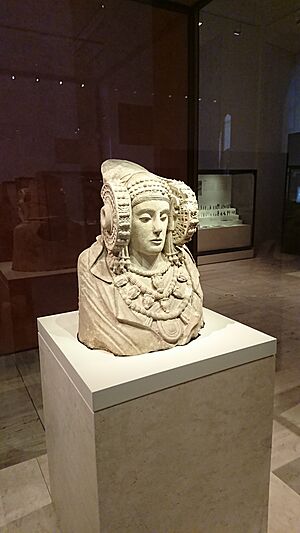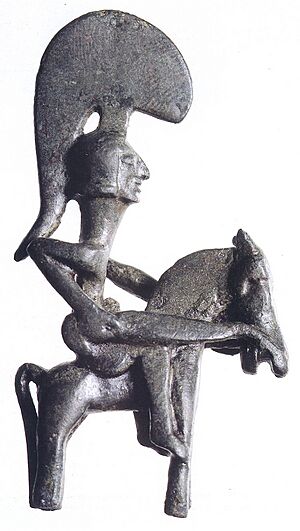Iberians facts for kids
The Iberians were ancient people who lived in the eastern and southern parts of the Iberian Peninsula (which is where modern-day Spain and Portugal are) a very long time ago. We know about them from writings by ancient Greek and Roman historians, starting around the 6th century BC. The Romans sometimes called them Hispani.
These people had their own unique culture. They spoke a special language called the Iberian language from about the 7th century BC until the 1st century BC. Some other groups, like the Vascones and the Aquitani, might have been related to the Iberians.
Who Were the Iberians?
The Iberians were a distinct cultural group. They were different from other people living in the Iberian Peninsula. Historians like Hecataeus of Miletus, Avienus, Herodotus, and Strabo wrote about them. These ancient writers helped us understand who the Iberians were and where they lived.
Iberian Neighbors
The Iberian Peninsula was home to many different groups of people. While the Iberians lived in the east and south, other groups lived in different areas.
- In the northern, central, and northwestern parts, you would find the Celts or Celtiberians. These groups had their own cultures and languages.
- Other groups included the Lusitanians, Vettones, and Turdetani. These people spoke languages that were part of the larger Indo-European languages family.
Iberian Warriors
The Iberians were known for being excellent soldiers. Because of their strong fighting skills, Iberian soldiers were often hired as mercenaries. This means they fought for other countries or empires for money. Starting around the 5th century BC, you could find Iberian soldiers fighting in battles in places like Italy, Greece, and especially on the island of Sicily.
Images for kids
-
Iberian relief, Mausoleum of Pozo Moro, 6th century BC, showing Hittite influence
-
Horseman from Iberian pottery, Alicante
-
Lord of the Horses, Villaricos (Almeria), Museu d'Arqueologia de Catalunya, Barcelona
-
Paleohispanic languages according to inscriptions (except Aquitanian – according to anthroponyms and theonyms used in Latin inscriptions)
-
Iberian scripts in the context of paleohispanic scripts
See also
 In Spanish: Iberos para niños
In Spanish: Iberos para niños










